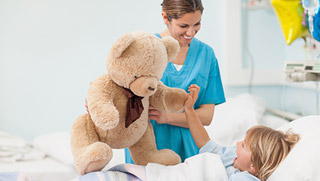When to Seek Emergency Care for your Child
It’s happened a thousand times- your child is running, falls, scrapes his knee and comes running, tears and all. Most of the time all that is required to heal is a little antiseptic, a bandage and a hug to make it all better. But what about those incidents that are a bit more serious - or even life threatening? If you’re a parent, then you have been at the crossroads of trying to determine whether or not the situation at hand requires a trip to the emergency room… and many times it can be a really tough decision.
We’ve provided some common scenarios and a few guidelines to help you determine when your child may need medical attention or simple tips on what you can do to help. (www.KidsHealth.org)

Bites & Scratches:
What to Do:- Wash the bite area with soap and water, and apply pressure with sterile gauze of a clean cloth if the bite is bleeding
- If the bleeding has stopped, apply antibiotic ointment
- Cover the area with a bandage or sterile gauze
Seek Medical Attention if:
- The wound won’t stop bleeding after 10 minutes and applying direct pressure
- The wound is deep or there are other severe injuries
- The attacking animal was stray, wild, or behaving strangely
- The bite or scratch becomes hot, red, swollen or increasingly painful
Strains and Sprains:
What to Do:- Think R.I.C.E for the first 48 hours after injury:
- Rest: Rest until it’s less painful.
- Ice: Wrap an icepack in a towel and place over injury part immediately. Continue for no more than 20 minutes at a time and four to eight times a day.
- Compression: Support the injured part with an elastic compressions bandage for 2 or more days.
- Elevation: Raise the injured part above the head level to decrease swelling.
Seek Medical Attention if:
- Severe pain when the injured part is touched or moved
- Continued trouble bearing weight
- Increased bruising
- Numbness or feelings of ‘pins and needles’
- A limb that looks bent or deformed
- Signs of infection
- No improvement of the strain or sprain after 5 to 7 days
Burns:
What to Do:- Remove clothing from the burned areas, except clothing stuck to the skin
- Run cool, not cold water over the burn until the pain lessens
- Lightly apply a gauze bandage
- Offer ibuprofen or acetaminophen for pain
- Do not put any ointment, butter, or other remedies on the burn- these can make it worse
- Bo not break the blisters that have formed
Seek Medical Attention if:
- The burned area is large (cover the area with a clean, soft cloth or towel)
- The burns came from a fire, an electrical wire or socket, or chemicals
- The burn is on the face, hands, feet, joints, or genitals
- The burn looks infected (with swelling, pus, or increased redness of streaking of the skin near the wound)
And don’t forget that when it comes time to choosing a hospital, make sure to visit an America’s Best Hospitals for Emergency Care so that you and your family are in the best hands.
Source: www.kidshealth.org
This information is for educational purposes only. For medical advice, diagnosis and treatment, consult your doctor.
